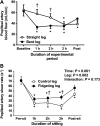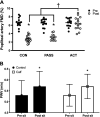Prolonged sitting and peripheral vascular function: potential mechanisms and methodological considerations
- PMID: 36794688
- PMCID: PMC10042610
- DOI: 10.1152/japplphysiol.00730.2022
Prolonged sitting and peripheral vascular function: potential mechanisms and methodological considerations
Abstract
Sitting time is associated with increased risks for subclinical atherosclerosis and cardiovascular disease development, and this is thought to be partially due to sitting-induced disturbances in macro- and microvascular function as well as molecular imbalances. Despite surmounting evidence supporting these claims, contributing mechanisms to these phenomena remain largely unknown. In this review, we discuss evidence for potential mechanisms of sitting-induced perturbations in peripheral hemodynamics and vascular function and how these potential mechanisms may be targeted using active and passive muscular contraction methods. Furthermore, we also highlight concerns regarding the experimental environment and population considerations for future studies. Optimizing prolonged sitting investigations may allow us to not only better understand the hypothesized sitting-induced transient proatherogenic environment but to also enhance methods and devise mechanistic targets to salvage sitting-induced attenuations in vascular function, which may ultimately play a role in averting atherosclerosis and cardiovascular disease development.
Keywords: macrovascular function; microcirculation; peripheral arterial disease; prolonged sitting; shear stress.
Conflict of interest statement
No conflicts of interest, financial or otherwise, are declared by the authors.
Figures





Similar articles
-
Effects of passive and active leg movements to interrupt sitting in mild hypercapnia on cardiovascular function in healthy adults.J Appl Physiol (1985). 2022 Mar 1;132(3):874-887. doi: 10.1152/japplphysiol.00799.2021. Epub 2022 Feb 17. J Appl Physiol (1985). 2022. PMID: 35175102 Free PMC article.
-
Brief periods of inactivity reduce leg microvascular, but not macrovascular, function in healthy young men.Exp Physiol. 2018 Oct;103(10):1425-1434. doi: 10.1113/EP086918. Epub 2018 Aug 15. Exp Physiol. 2018. PMID: 30110509
-
Impacts of prolonged sitting with mild hypercapnia on vascular and autonomic function in healthy recreationally active adults.Am J Physiol Heart Circ Physiol. 2020 Aug 1;319(2):H468-H480. doi: 10.1152/ajpheart.00354.2020. Epub 2020 Jul 10. Am J Physiol Heart Circ Physiol. 2020. PMID: 32648821 Free PMC article.
-
Sitting leg vasculopathy: potential adaptations beyond the endothelium.Am J Physiol Heart Circ Physiol. 2024 Mar 1;326(3):H760-H771. doi: 10.1152/ajpheart.00489.2023. Epub 2024 Jan 19. Am J Physiol Heart Circ Physiol. 2024. PMID: 38241008 Free PMC article. Review.
-
The Acute Effects of Prolonged Uninterrupted Sitting on Vascular Function: A Systematic Review and Meta-analysis.Med Sci Sports Exerc. 2022 Jan 1;54(1):67-76. doi: 10.1249/MSS.0000000000002763. Med Sci Sports Exerc. 2022. PMID: 34334722
Cited by
-
Joint exposure to PM2.5, warm-season heat, and sedentary behavior accelerates incident lung cancer in ageing Chinese adults: evidence from CHARLS.Front Public Health. 2025 Jul 8;13:1622767. doi: 10.3389/fpubh.2025.1622767. eCollection 2025. Front Public Health. 2025. PMID: 40697836 Free PMC article.
-
Exercise snacks and physical fitness in sedentary populations.Sports Med Health Sci. 2024 Feb 27;7(1):1-7. doi: 10.1016/j.smhs.2024.02.006. eCollection 2025 Jan. Sports Med Health Sci. 2024. PMID: 39649791 Free PMC article. Review.
-
A tree-based corpus annotated with Cyber-Syndrome, symptoms, and acupoints.Sci Data. 2024 May 10;11(1):482. doi: 10.1038/s41597-024-03321-0. Sci Data. 2024. PMID: 38730023 Free PMC article.
-
Metabolome Alterations Associated with Three-Month Sitting-Time Reduction Among Sedentary Postmenopausal Latinas with Cardiometabolic Disease Risk.Metabolites. 2025 Jan 26;15(2):75. doi: 10.3390/metabo15020075. Metabolites. 2025. PMID: 39997700 Free PMC article.
-
Physiology of sedentary behavior.Physiol Rev. 2023 Oct 1;103(4):2561-2622. doi: 10.1152/physrev.00022.2022. Epub 2023 Jun 16. Physiol Rev. 2023. PMID: 37326297 Free PMC article. Review.
References
Publication types
MeSH terms
Grants and funding
LinkOut - more resources
Full Text Sources
Medical

